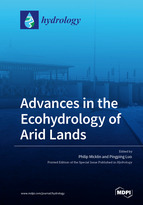Advances in the Ecohydrology of Arid Lands
A special issue of Hydrology (ISSN 2306-5338). This special issue belongs to the section "Ecohydrology".
Deadline for manuscript submissions: closed (28 August 2021) | Viewed by 1017915
Special Issue Editors
Interests: water resource management; applied hydrology; lake and river hydrology; water management issues in Russia and Central Asia; satellite imagery use in studying water resources
Interests: engaged in hydrology and water resources; carrying out theoretical research on extreme hydrological sequence reconstruction; forest hydrology for flood and drought disasters, and dynamic mechanism research on the impact of rainfall uncertainty on flood and drought disasters
Special Issues, Collections and Topics in MDPI journals
Special Issue Information
Dear Colleagues,
This is an invitation to submit a manuscript for publication in a special issue (SI) of Hydrology, a peer reviewed open access, on-line journal published by MDPI (Multi-Disciplinary Publishing Institute) located in Basel, Switzerland. MDPI is rated as one of the best open access publishers. It has 215 technical and scientific journals in its purview. Hydrology publishes a broad range of articles. It also has high visibility being covered by Emerging Sources Citation Index (ESCI) in Web of Science, as well as GeoRef and Scopus (2018 Cite Score: 2.02).
The title of the SI is “Advances in the Ecohydrology of Arid Lands.” Ecohydrology is an emerging, cross disciplinary subfield of hydrology devoted to the mutual interactions between water and ecosystems (Acreman, Blake, Carvalho et al. 2015). Today, the important question of what these interactions mean for human society and how human society impacts these interactions is also part of this subject. The specific climatic/geographic focus here is on arid lands broadly defined as water deficit regions where potential evapotranspiration (PET) exceeds precipitation (P). Such lands exceed 41% of the world’s terrestrial area and are found on all continents except Antarctica (D’Odorico and Porporato 2006). They range from the climatic/vegetation classifications deserts and semi-deserts that are excessively dry most of the time through True Steppes to Wooded Steppes, Mediterranean areas and Tropical Savannas which suffer from moderately dry conditions parts of the year.
The intent of the SI is to present scientifically accurate information on the current state of leading ecohydrology oriented research on arid lands. The Guest Editors (GEs) for the SI are open to a broad range of topics with the understanding they should relate to arid lands and represent best thinking in the field. Interaction of terrestrial water balance components (precipitation, evaporation, ground water, river flow) with faunal, floral, and soil ecosystem elements are welcomed as are studies of lake and wetland ecohydrology. Case studies illustrating modern ecohydrology principles and their practical application are also within the scope of the Special Issue. The organization of the Special Issue will depend on the number and type of maunscripts accepted for publication.
The submission period for manuscripts will extend three months from the date on this invitation. The instructions for manuscript preparation and submission are available at the Journal’s website (www.mdpi.com/journal/hydrology). Once a manuscript is received by Hydrology it will be initially screened for acceptability by that journal’s editors. If acceptable, the manuscript will then be sent for peer review. The peer reviews and the manuscript will then be carefully reviewed by the GEs and a decision made by them in consultation with the managing editor (ME) of the SI on the manuscript (accept, reject or ask author for revisions).
Literature Cited
Acreman, M.C., Blake, James R. Carvalho, Laurence R. et al (2015). “Ecohydrology,” Chapter 9, pp. 267-301. In Rodda, John C., and Mark Robinson. Progress in Modern Hydrology: Past, Present and Future, John Wiley & Sons, Incorporated. (ProQuest Ebook)
Central, http://0-ebookcentral-proquest-com.brum.beds.ac.uk/lib/wmichlib-ebooks/detail.action?docID=4040936).
D’Odorico, P. and Porporato, A. (2006). “Ecohydrology of Arid and Semiarid Ecosystems: An Introduction, pp. 1-11.” In D’Odorico, P. and Porporato, A (eds.) Dryland Ecohydrology, Springer: Dordrecht, The Netherlands.
Dr. Philip MicklinProf. Pingping Luo
Guest Editor
Manuscript Submission Information
Manuscripts should be submitted online at www.mdpi.com by registering and logging in to this website. Once you are registered, click here to go to the submission form. Manuscripts can be submitted until the deadline. All submissions that pass pre-check are peer-reviewed. Accepted papers will be published continuously in the journal (as soon as accepted) and will be listed together on the special issue website. Research articles, review articles as well as short communications are invited. For planned papers, a title and short abstract (about 100 words) can be sent to the Editorial Office for announcement on this website.
Submitted manuscripts should not have been published previously, nor be under consideration for publication elsewhere (except conference proceedings papers). All manuscripts are thoroughly refereed through a single-blind peer-review process. A guide for authors and other relevant information for submission of manuscripts is available on the Instructions for Authors page. Hydrology is an international peer-reviewed open access monthly journal published by MDPI.
Please visit the Instructions for Authors page before submitting a manuscript. The Article Processing Charge (APC) for publication in this open access journal is 1800 CHF (Swiss Francs). Submitted papers should be well formatted and use good English. Authors may use MDPI's English editing service prior to publication or during author revisions.
Keywords
- ecohydrology
- arid lands
- lakes
- rivers
- water balance
- wetlands
- soils






